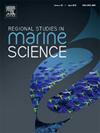地中海泻湖和海洋之间鱼类运动的物候学:来自声学相机和渔民当地生态知识的见解
IF 2.4
4区 环境科学与生态学
Q3 ECOLOGY
引用次数: 0
摘要
研究鱼类运动是提高我们对鱼类生态学认识的一项重要而复杂的任务。本研究同时使用声学相机视频(ACV)和专业渔民的当地生态知识(LEK)来描述泻湖和海洋之间的鱼类运动。结果表明,ACV与渔民LEK具有一致性和互补性。根据ACV数据,在鱼类群落中确定了三个大小组:<; 15 cm, 15 - 35 cm和>; 35 cm。渔民报告的鱼<; 15 cm可能是小物种的幼鱼或成年个体,15 - 35 cm主要是Gilthead seabreams (Sparus aurata), >; 35 cm主要是欧洲鲈(Dicentrarchus labrax)。ACV数据检测到的鱼类进入泻湖(2月至4月)和离开海洋(9月至11月)的主要时期与渔民对Gilthead海鲷和欧洲海鲈的LEK相匹配。鱼类的日活动<; 15 cm和>; 35 cm表现为非同步物候,前者在夜间较多,后者在下午较多。本研究强调了结合ACV和渔民LEK来研究鱼类运动物候的额外好处,从而提供了新的研究机会。本文章由计算机程序翻译,如有差异,请以英文原文为准。
Phenology of fish movements between a mediterranean lagoon and the sea: Insights from acoustic camera and fishers’ local ecological knowledge
Studying fish movement is an essential and complex task that is necessary to improve our understanding of fish ecology. The present study simultaneously used Acoustic Camera Videos (ACV) and professional fishers’ Local Ecological Knowledge (LEK) to describe fish movements between a lagoon and the sea. Results showed consistency and complementarity between ACV and fishers’ LEK. Three size groups were identified in the fish community based on ACV data: < 15 cm, 15–35 cm, and > 35 cm. Fishers reported that fish < 15 cm could either be juveniles or adult individuals of small species, those 15–35 cm were mainly Gilthead seabreams (Sparus aurata) and those > 35 cm were mainly European seabass (Dicentrarchus labrax). The main periods during which fish entered into the lagoon (February-April) and exited to the sea (September-November) detected on ACV data matched fishers’ LEK for the Gilthead seabream and the European seabass. Daily movements of fish < 15 cm and > 35 cm showed asynchronous phenology, the former being more abundant during night-time hours, and the latter during the afternoon. This study highlights the additional benefits of combining ACV and fishers’ LEK to study fish movement phenology, and thus presents new research opportunities.
求助全文
通过发布文献求助,成功后即可免费获取论文全文。
去求助
来源期刊

Regional Studies in Marine Science
Agricultural and Biological Sciences-Ecology, Evolution, Behavior and Systematics
CiteScore
3.90
自引率
4.80%
发文量
336
审稿时长
69 days
期刊介绍:
REGIONAL STUDIES IN MARINE SCIENCE will publish scientifically sound papers on regional aspects of maritime and marine resources in estuaries, coastal zones, continental shelf, the seas and oceans.
 求助内容:
求助内容: 应助结果提醒方式:
应助结果提醒方式:


